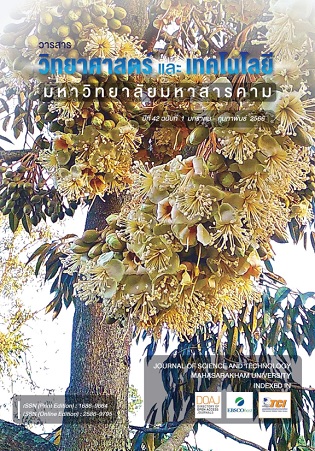Development of Indigo Blue Determination Using UV-Visible spectrophotometry and Application to Quality Evaluation of Indigo Paste Samples in Sakon Nakhon Province
Main Article Content
Abstract
This research aimed to develop quantitative determination of indigo blue content in indigo paste by UV-vis spectrophotometry. The indigo blue was transformed to be indigo carmine by a sulfonation reaction with sulfuric acid. Indigo carmine is a stable and water-soluble form of indigo blue, which presented good absorbance at the wavelength 610 nm. For indigo paste sample preparation, it was found that the optimum ratio of indigo paste amount to volume of concentrated sulfuric acid (98%w/v), and reaction time were 1:12 (g:mL) and 50 min, respectively. The proposed method was applied to analyze indigo blue content in 34 indigo paste samples from different communities in Sakon Nakhon province. The results showed that the amount of indigo blue in the indigo paste samples was in the range of 0.09 - 2.23%w/w. The proposed method of indigo blue determination by UV-vis spectrometry could accurately and precisely determine indigo blue content in indigo paste samples. Moreover, this data could be used to be a guideline for evaluating the quality and the price of indigo paste appropriately.
Article Details
References
จุฑามาส ศรีสำ ราญ. (2558). โครงการวิจัยและพัฒนาการผลิตครามพื้นที่จังหวัดสกลนคร. กรมวิชาการเกษตร.
งานส่งเสริมอุตสาหกรรมครัวเรือน ศูนย์ศึกษาการพัฒนาภูพานอันเนื่องมาจากพระราชดำริ จังหวัดสกลนคร. (2555). คู่มือการผลิตผ้าย้อมคราม (พิมพ์ครั้งที่ 2).
มูฟเม้น เจนทรี.
นฤมล ธนานันต์, ศุภรัตน์ บัวบาน, ธีระชัย ธนานันต์. (2563). การประเมินความสัมพันธ์ทางพันธุกรรมของพืชครามสกุล Indigofera โดยใช้เทคนิค สก๊อต. Thai Journal of Science and Techno-logy, 2, 333-341.
นัฐวุธ บุตรดี และ สุรกิจ พันธ์รัก. (2562). ปัจจัยที่มีผลต่อปริมาณอินดิโกบลูในต้นคราม [ปริญญานิพนธ์ วิทยาศาสตรบัณฑิต, มหาวิทยาลัยราชภัฏสกลนคร].
นิวส์มอนิเตอร์. (2561).สภาหัตถศิลป์โลกรับรองสกลนครเป็น “World Craft City for Natural Indigo”. มติชนออนไลน์.
พัชนีย์ ด้วงนิล. (2554). การพัฒนาวิธีการที่เหมาะสมสำหรับการหาปริมาณอินดิโกในครามหมัก.
รัตนพล มงคลรัตนาสิทธิ์, จรูญ คล้ายจ้อย, วาสนา ช้างม่วง, นงนุช ศศิธร และ เกษม มานะรุ่งวิทย์. (2560). คู่มือองค์ความรู้ การย้อมครามธรรมชาติแบบใหม่บน
เส้นด้ายไหมและฝ้ายเชิงพานิชย์. สำนักคณะกรรมการวิจัยแห่งชาติ. ก-ฮ.
อนุรัตน์ สายทอง. (2543). การผลิตสีครามจากต้นคราม. ศูนย์ครามสกลนคร ราชภัฏสกลนคร.
อังคณา เทียนกล่ำ . (2555). การศึกษาลักษณะทางพฤกษศาสตร์ การเพิ่มผลผลิตใบ ปริมาณสี และครามผง (Indigofera tentoria Linn.). แก่นเกษตร, (40), 44-52.
Abdelhadi, B., Mohand, S.O., Louis-Charles De M. (2010). Photocatalytic Decolourization of Indigo Carmine on 1,10-phenanthrolinium Intercalated Bentonite under UV-B and Solar Irradiation. Journal of Photochemistry and Photobiology A: Chemistry, 212, 101-106.
Ann, C. & Kwan-nan, Y. (1984). Blue dye identification on cellulosic fibers: indigo, logwood, and Prussian blue. Journal of the American Institute for Conservation, 24, 33-39.
AOAC. (2005). Official methods of analysis (18th eds). Association of Official Analytical Chemists; Arlington.
Gilbert, K.G., Hill, D.J., Crespo, C., Mas, A., Lewis, M., Rudolph, B. & Cooke, D.T. (2000). Qualitative analysis of indigo precursors from Woad by HPLC and HPLC-MS. Phytochemical analysis, 11, 18-20.
Iqbal, T.S., Babur, Z.C., Martin, J.S. and Robert, W. (2004). Analysis of the conversion of indigo into Indigo carmine dye using SERRS. Chemical Communications, 1436-1437.
Lívia, F.Z., Ivanise, G., Maria, E.V.S., Patricia, A.M. (2014). Freitas. adsorption of 5.5’-disulfonicindigotin (5.5’-DI) onto green coconut fiber (Cocosnucifera L.): Kinetic and isotherms. Journal of Encapsulation and Adsorption Sciences, 4, 37-52.
Nittaya, C., Sorasak L. & Suree, P. (2002). Pigment Extraction techniques from the leaves of Indigofera tinctoria Linn. and baphicacanthus cusia brem. and chemical structure analysis of their major components. Chiangmai University Journal, 1 (2),
-160.
Novotná, P., Boon, J.J., Van der H.J. and Pacáková V. (2003). Photoegradation of indigo in dichloromethane solution. Coloration Technology, 119 (3), 121-186.
Purnama, H., Hidayati, N., Safitri D. & Rahmawati S. (2017). Effect of initial treatment in the preparation of natural indigo dye from indigofera tinctorial. Proceedings of the 3rd International Conference on Engineering, Technology, and Industrial Application
(ICETIA 2016).
Railson, O.R., Maria, V.C.A., Wilton, S.L., José, T.S., Valderi, D.L. (2020). Degradation of indigo carmine by photo-Fenton, Fenton, H2
O2 /UV-C and direct UV-C: Comparison of pathways, products and kinetics. Journal of Water Process Engineering, 37, 101535.
Shan, L., Anthony, B.C., Ruyan, F. & Yuhua, W. (2019). Identity blues: The ethnobotany of the indigo dyeing by Landian Yao (Iu Mien) in Yunnan, Southwest China. Journal of Ethno- biology and Ethnomedicine, 15, 1-14.
Sunhwa, P., Ji-Young, R., Jiyoung, S., Hor-Gil, H. (2012). Isolation and characterization of alkaliphilic and thermotolerant bacteria that reduce insoluble indigo to soluble Leuco-indigo from indigo dye vat. Journal of the Korean Society for Applied Biological
Chemistry, 55, 83-88.
Tayade, P. & Adivarekar, R. (2014). Extraction of indigo dye from Couroupita guianensis and its application on cotton fabric. Tayade and Adivarekar Fashion and Textiles, 1, 1-16.
Valentina, B., Martí, C.& Carmen, G-B. (2014). A critical comparison of methods for the analysis of indigo in dyeing liquors and effluents. Materials, 7, 6184-6193.
VWR International. (2020). Indigo carmine solution R1. Zhang, D., Lin X., Chen X., Liu J. (2013). Influence of orchard-intercropping mode on plant height and branch growth of Baphicacanthus cusia (Nees) Bremek. Journal of Guangzhou University of Traditional, 1 (30), 83-7.


